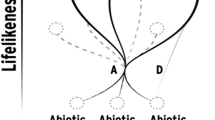Abstract
The present retrospective concerns the discovery and development of the archaea, the so-called 'third form of life' that no one anticipated and many did not, and still do not want. In its birth pangs, which the archaea had a plenty, the concept encountered biology unmasked; for it ran up against some of the key struts in the 20th century biological edifice. Consequently, the history of the development of the archaeal concept provides an excellent window on certain of the weaknesses in the 20th century biology paradigm, weaknesses that have now led that paradigm to a conceptual dead end. On the other hand, the archaeal concept has also provided us one of the pillars on which a new holistic paradigm for biology can be built. So, it would seem of value to retrace some of the twists and turns in the history of the development of the archaeal concept. Given my position vis-à-vis the archaea, my account will be a personal one.
Similar content being viewed by others
References
Bell SD and Jackson SP (2001) Mechanism and regulation of transcription in archaea. Curr Opin Microbiol 4: 208–213
Bohm D (1969) Some remarks on the notion of order. In: Waddington CH (ed) Towards a Theoretical Biology: 2.Sketches, pp 18–40. Edinburgh Press, Edinburgh
Brock TD (1978) Thermophilic Microorganisms and Life at High Temperatures, p 174. Springer-Verlag, Berlin
Cavalier-Smith T (2002) The neomuran origin of archaebacteria, the negibacterial root of the universal tree and bacterial megaclassification. Int J Syst Evol Microbiol 52: 7–76
Chatton E (1937) Titres et travaux scientifiques. Sete, Sotano
Crick FHC (1958) The biological replication of macromolecules. Symp Soc Exp Biol 12: 138–163
DeLong EF, Wickham GS and Pace NR (1989) Phylogenetic stains: ribosomal RNA-based probes for the identification of single cells. Science 243: 1360–1363
Fitz-Gibbon ST and House CH (1999) Whole genome-based phylogenetic analysis of free-living microorganisms. Nucleic Acids Res 27: 4218–4222
Fox GE, Pechman KR and Woese CR (1977a) Comparative cataloging of 16S ribosomal ribonucleic acid: molecular approach to procaryotic systematics. Int J Syst Bacteriol 27: 44–57
Fox GE, Magrum LJ, Balch WE, Wolfe RS and Woese CR (1977b) Classification of methanogenic bacteria by 16S ribosomal RNA characterization. Proc Natl Acad Sci USA 74: 4537–4541
Fox GE, Stackebrandt E, Hespell RB, Gibson J, Maniloff J, Dyer TA, Wolfe RS, Balch WE, Tanner RS, Magrum LJ, Zablen LB, Blakemore R, Gupta R, Bonen L, Lewis BJ, Stahl DA, Luehrsen KR, Chen KN and Woese CR (1980) The phylogeny of prokaryotes. Science 209: 457–463
Gamow G (1954) Possible relations between deoxyribonucleic acid and protein structures. Nature 173: 318
Gilbert SF, Opitz JMand Raff RA (1996) Resynthesizing evolutionary and developmental biology. Dev Biol 173: 357–372
Graham DE, Overbeek R, Olsen GJ and Woese CR (2000) An archaeal genomic signature. Proc Natl Acad Sci USA 97: 3304–3308
Gupta RS (2003) Evolutionary relationships among photosynthetic bacteria. Photosynth Res 76: 173–183
Gupta RS and GB Golding (1993) Evolution of HSP70 gene and its implications regarding relationships between archaebacteria, eubacteria, and eukaryotes. J Mol Evol 37: 573–582
Huet J, Schnabel R, Sentenac A and Zillig W(1983) Archaebacteria and eukaryotes possess DNA-dependent RNA polymerases of a common type. EMBO J 2: 1291–1294
Kandler O and Hippe H (1977) Lack of peptidoglycan in the cell walls of Methanosarcina barkeri. Arch Microbiol 113: 57–60
Langer D, Hain J, Thuriaux P and Zillig W (1995) Transcription in archaea: similarity to that in Eucarya. Proc Natl Acad Sci USA 92: 5768–5772
Olsen GJ and Woese CR (1996) Lessons from an archaeal genome: what are we learning from Methanococcus jannaschii? Trends Genet 12: 377–379
Olsen GJ, Lane DJ, Giovannoni SJ, Pace NR and Stahl DA (1986) Microbial ecology and evolution: a ribosomal RNA approach. Ann Rev Microbiol 40: 337–365
Pennisi E (1998)Genome data shake tree of life. Science 280: 672–674
Pennisi E (1999) Is it time to uproot the tree of life? Science 284: 1305–1307
Reeve JN, Sandman K and Daniels CJ (1997) Archaeal histones, nucleosomes, and transcription initiation. Cell 89: 999–1002
Sanger F and Thompson EOP (1953) The amino-acid sequence in the glycyl chain of insulin. Biochem J 53: 353–374
Sanger F and Tuppy H (1951) The amino-acid sequence in the phenylalanyl chain of insulin. Biochem J 49: 481–490
Sanger F, Brownlee GG and Barrell BG (1965) A two-dimensional fractionation procedure for radioactive nucleotides. J Mol Biol 13: 373–398
Snel B, Bork P and Huynen M (1999) Genome phylogeny based on gene content. Nat Genet 21: 17–25
Stanier RY and van Niel CB (1962) The concept of a bacterium. Arch Mikrobiol 42: 17–35
Steitz JA (1978) Methanogenic bacteria. Nature 273: 10
Tornabene TG and Langworthy TA (1979) Diphytanyl and dibiphytanyl glycerol ether lipids of methanogenic archaebacteria. Science 203: 51–53
Woese CR (1982) Archaebacteria and cellular origins. An overview. Zbl Bakt Hyg I Abt. Orig C 3: 1–17
Woese CR (1987) Bacterial evolution. Microbiol Rev 51: 221–271
Woese CR (2001) Translation: in retrospect and prospect. RNA 7: 1055–1067
Woese CR, Magrum LJ and Fox GE (1978) Archaebacteria. J Mol Evol 11: 245–251
Woese CR, Gupta R, Hahn CM, Zillig Wand Tu J (1984) The phylogenetic relationships of three sulfur dependent archaebacteria. Syst Appl Microbiol 5: 97–105
Woese CR, Stackebrandt E, Macke TJ and Fox GE (1985) A phylogenetic definition of the major eubacterial taxa. Syst Appl Microbiol 6: 143–151
Woese CR, Olsen GJ, Ibba M and Söll D (2000) Aminoacyl-tRNA synthetases, the genetic code, and the evolutionary process. Microbiol Mol Biol Rev 64: 202–236
Wolfe RS (1992) Biochemistry of methanogenesis. Biochem Soc Symp 58: 41–49
Wolfe R (2003) The Archaea: a personal overview of the formative years. In: The Prokaryotes, 3rd edition (in press)
Author information
Authors and Affiliations
Rights and permissions
About this article
Cite this article
Woese, C.R. The Archaeal Concept and the World it Lives in: A Retrospective. Photosynthesis Research 80, 361–372 (2004). https://doi.org/10.1023/B:PRES.0000030445.04503.e6
Issue Date:
DOI: https://doi.org/10.1023/B:PRES.0000030445.04503.e6




